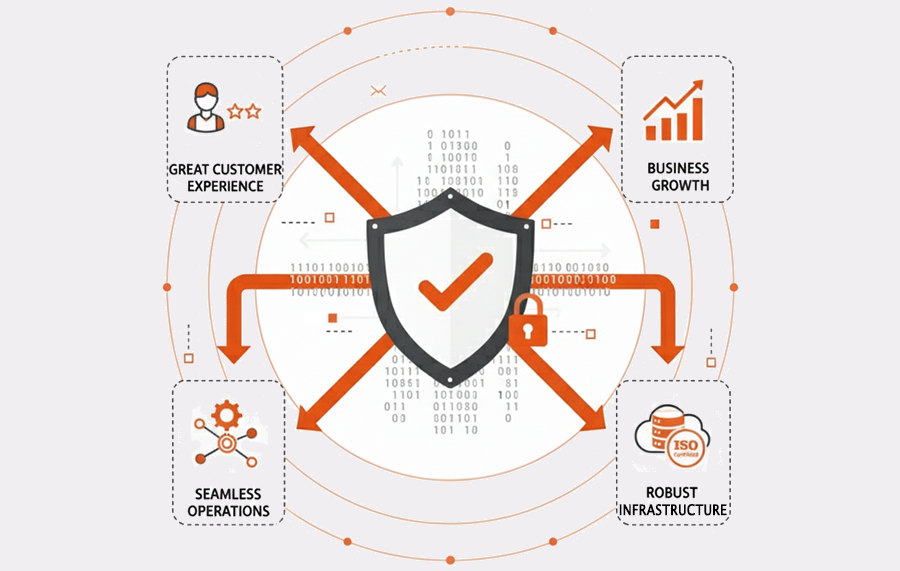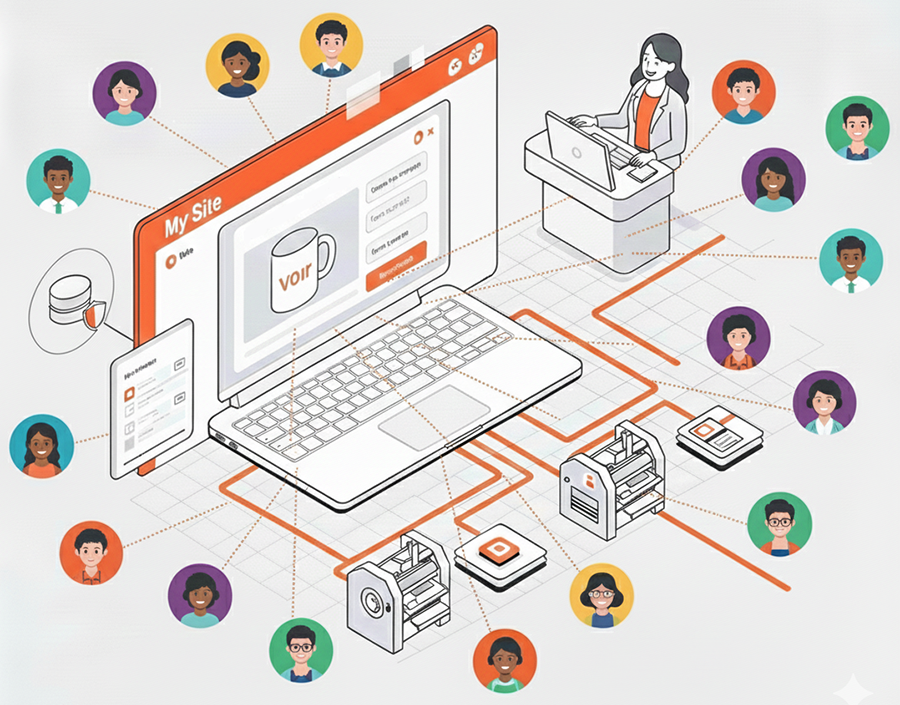7 November 2025
Web-to-Print Risk: What's Your Exposure from Hosting and Development Location?

When a Print Service Provider (PSP) evaluates a Web-to-Print vendor, the true measure of risk is not where the sales headquarters are located, but where the data is processed (hosting) and where the platform is built (development). The location of these "back office" functions dictates the risk of massive fines and liability passed down from your corporate clients (Data Controllers).
I. Jurisdictional Risk: The Liability Cascade
The vendor's registered address (Headquarters) is irrelevant to data and IP compliance. The governing laws are determined by the location of the data subjects (your customers' customers) and the physical servers. As the Data Controller (the Corporate Client) is ultimately liable, any failing by the Web-to-Print (W2P) platform (the Sub-Processor) flows directly up to the PSP (the Processor).
Risk Area | Headquarter Location (Front Office) | Processing Location (Back Office) |
Legal Basis | Dictates where you sue the vendor (contract law). | Dictates the legal framework for data access (e.g., GDPR, CCPA, CLOUD Act), which impacts your corporate client's compliance. |
Data Security | Irrelevant. | Determines the physical security and access laws enforced by local governments. |
Compliance Costs | Low impact. | High impact. The PSP bears the audit and contractual cost of assuring the corporate client that the SaaS provider meets requirements. |
Financial Liability | Minimal direct risk to the PSP. | High. A breach here means the corporate client (Controller) faces fines, which they will recoup from the PSP (Processor). |
II. Data Hosting Location: Compliance, Scalability, and Sovereign Access
The physical location of the server determines the applicable data privacy and sovereignty laws, but the infrastructure choice determines performance and reliability.
A. Legal Compliance & Data Residency
- Risk for the PSP: Hosting customer PII (including names, addresses, and order history) outside of regions with "adequacy decisions" (UK, EU/EEA, US under the DPF, etc.) triggers complex requirements like Standard Contractual Clauses (SCCs) or UK International Data Transfer Agreements (IDTAs). If the PSP fails to get proper assurances from the W2P SaaS vendor, the PSP is in breach of its contract with the corporate client and risks severe financial penalties and regulatory fines (up to 4% of global turnover) being levied against the Controller, who will then pursue the PSP for indemnity.
- Mitigation: The contract must include a Data Residency Guarantee stating that all sensitive customer data will be physically stored and processed exclusively in UK, US, or EU regions.
B. High Availability, Scalability, and Resilient Cloud Architecture
- Risk for the Corporate Client: Relying on non-accredited infrastructure or self-managed data centres inherently introduces weaknesses in resilience, leading to single points of failure, manual scaling limits, and potential catastrophic outages. This translates directly to an inability to meet contracted uptime guarantees, violating the Availability objective of ISO/IEC 27001 and undermining the core principles of ISO 22301 (Business Continuity) by failing to maintain service delivery during periods of disruption or peak demand.
- Mitigation: Ensure the Web-to-Print SaaS provider can demonstrate a robust approach to infrastructure resilience and quality assurance, ensuring compliance with ISO 22301 (Business Continuity). Specifically, they must demonstrate that they leverage resilient and proven Design & Reliability (D&R) planning and testing, such as:
- Active-Active Failover: Implementing a fully redundant architecture where critical services are deployed across geographically separate locations, enabling near-instant failover with zero data loss.
- Automated Elasticity: Utilising dynamic, automated scaling groups to instantly handle unpredictable surges in client order volumes and peak seasonal workloads.
- Tested Business Continuity: Providing formal, documented proof of regular testing and validation of Disaster Recovery (DR) and Business Continuity (BC) plans to ensure seamless service restoration and the ability to handle peak volumes under crisis conditions.
III. Development Location: The Risk of Low-Cost Jurisdictions to Platform Integrity
If the Web-to-Print platform's development (where the code is written) is outsourced to teams in low-cost jurisdictions, the security risk to the intellectual property (IP) and system integrity skyrockets, directly compromising the data security the corporate client requires.
If you think good architecture is expensive, try bad architecture.
Bjarne Stroustrup (Creator of the programming language C++)
A. Insider Threat and Malicious Code Injection
Developers hold the "keys to the kingdom"- access to source code, deployment pipelines, and production environments. Lax development controls in an outsourced location create a direct, catastrophic risk to the PSP and its corporate client.
- Risk: A development partner with high staff turnover or lax internal controls increases the risk of malicious code injection (backdoors, logic bombs) or a major data breach caused by a disgruntled employee or a compromised contractor (insider threat). This risk is compounded by the threat of IP leakage, where proprietary algorithms or database structures are copied, making the threat actor better equipped to execute a breach on the live Web-to-Print platform.
- Actionable Due Diligence: Require documentation of their security practices, including:
- Vetting: Background checks on all key developers.
- Code Review: Mandatory review for all production code deployments.
- Access Control: Strict Need-to-Know (least privilege) access to production systems, automatically revoking access upon termination.
- IP Protection: Proof of a legally sound IP Assignment Deed (Work-for-Hire) specific to the development country's laws, confirming 100% IP ownership rests with the SaaS vendor, which acts as a secondary layer of risk control.
B. Code Quality, Technical Debt, and Maintainability
Outsourcing development purely to chase the lowest labour cost introduces a high risk of poor code quality, which translates into an unstable system and high Total Cost of Ownership (TCO) over the contract life.
- Risk: For mission-critical platforms like Web-to-Print systems, the choice of a low-cost development jurisdiction is a direct risk signal. This cost-driven approach forces developers to prioritise speed over quality, systematically neglecting robust system architecture, peer-review, and integrated testing. The direct result is a brittle Web-to-Print system characterised by system fragility - where frequent, complex bugs disrupt client workflows and order processing - and a relentless increase in technical debt (poorly written code). This poor quality makes the platform inherently expensive to maintain, slow to adapt, and risky to operate in the long term, eventually leading to costly downtime and the need for early, disruptive replacement for the corporate client.
- Mitigation: Demand proof that the development team follows rigorous, auditable quality standards, including:
- Automated Testing: Requirement for unit, integration, and end-to-end testing integrated into the CI/CD pipeline.
- Architectural Oversight: Evidence that senior, local architects oversee code contributions to ensure best practices are maintained and technical debt is actively managed and reduced.
IV. The Ultimate Requirement and Competitive Advantage
The central risk is a lack of verifiable transparency and demonstrable control over the technology supply chain. The provider’s sales presence is irrelevant; their security protocols at the point of development and data processing are everything. Corporate clients will demand proof of control over the entire supply chain.
The contractual requirement must be demonstrable organisational maturity and rigorous process control. If the provider cannot transparently evidence that the teams building the Web-to-Print platform follow mature internal processes—and that their hosting is managed under a certified standard like ISO 27001 (global credibility) or SOC 2 Type II (US enterprise trust)—the risks are unacceptable to your high-value corporate customers. The focus must be on verifiable process control that eliminates systemic failure points.
V. The Long-Term Reward: Competitive Advantage and TCO Reduction
These stringent security requirements are not just defensive costs; they are proactive investments that dramatically improve your competitive position and reduce the Total Cost of Ownership (TCO) over the contract's lifespan.
A. Win Enterprise Deals and Shorten Sales Cycles
In the Web-to-Print SaaS sector, security certifications are the fastest path to closing enterprise deals. Procurement teams view ISO 27001 and SOC 2 Type II compliance not as optional extras, but as proof of operational maturity.
- Market Differentiator: Compliance transforms your security posture from a potential liability into a unique selling proposition (USP). You can immediately qualify for RFPs (Request for Proposals) that exclude non-compliant vendors.
- Simplified Due Diligence: Instead of spending weeks on exhaustive security questionnaires and due diligence, we provide transparent documentation of our operational maturity, including our partner's ISO certifications and full evidence of our in-house UK development processes. This transparency simplifies the client's risk assessment for the Web-to-Print system, significantly accelerating the vendor onboarding process.
B. Scalability, Reliability, and TCO Efficiency
Leveraging robust cloud infrastructure like AWS is an investment in elasticity, which fundamentally lowers the operational TCO and fuels sustainable growth.
- Cost-Efficient Pricing: The platform's use of a pay-as-you-go cloud model eliminates the massive, fixed capital expenditure (CapEx) associated with owning physical servers. This optimised Operational Expenditure (OpEx) model allows us to offer more competitive and stable long-term subscription pricing for the Web-to-Print service, directly benefitting the client's TCO.
- Guaranteed Uptime: Multi-AZ deployments and automated failover capabilities baked into modern cloud architecture guarantee higher uptime metrics (we have an SLA of 99.95% or better) than any single-server solution. This resilience ensures uninterrupted service, preventing costly lost revenue and client churn caused by system outages.
- Future-Proofing: Cloud infrastructure provides instant access to advanced features (AI services, global expansion, enhanced security services) without requiring core architectural changes. This flexibility ensures your W2P platform can adapt to future client demands and remain technologically competitive without expensive, disruptive overhauls.
C. Design, Reliability, and Continuous Engineering (D&R)
Our 100% in-house, UK-based development team is mandated to follow stringent Design and Reliability (D&R) principles. This focus on engineering quality throughout the development lifecycle is a key defense against technical debt, ensuring the platform remains stable, performant, and easily maintainable for the long term.
- Lower Technical Debt: By prioritising clean architecture, test-driven development, and mandatory peer-review for all code deployments, we significantly reduce the technical debt that plagues outsourced or rushed software projects. Lower technical debt translates directly into faster feature development, fewer bugs, and improved long-term reliability.
Left unchecked, technical debt will ensure that the only work that gets done is unplanned work!
Gene Kim (Author, The Phoenix Project)
- Stability through Continuous Integration: Our continuous integration/continuous deployment (CI/CD) pipeline is designed with automated, multi-stage testing, ensuring that every update improves platform stability rather than jeopardising it. This rigorous approach to D&R guarantees that the total cost of ownership (TCO) remains predictable and low over the life of the contract.
VI. Vendor Assurance: Stability, Compliance, and a Hybrid Future
For over two decades, Vpress has established itself as a cornerstone of the Web-to-Print industry, translating deep market experience into a secure and highly reliable solution. Our maturity is reflected in our robust, hybrid cloud architecture, designed specifically to meet the non-negotiable standards of large enterprise clients.
Every shortcut in engineering is a withdrawal from future competitive velocity. You don't get faster by cutting corners; you simply place your customer's core business operations in direct jeopardy.
James Hall, Technical Director, Vpress
A. Dedicated UK Private Cloud and Operational Maturity
To ensure absolute control over data sovereignty and performance, the core processing platform is managed within a high-security, private cloud environment located exclusively in the UK. This infrastructure is overseen by a trusted, long-standing UK hosting partner—a recognised expert in managed cloud services with decades of operational experience.
- Certified Operations: The infrastructure and operational processes are independently certified, with our long-standing UK hosting partner holding the following key ISO accreditations:
- ISO/IEC 27001: The auditable international standard for Information Security Management Systems (ISMS), ensuring data confidentiality, integrity, and availability.
- ISO 22301: The international standard for Business Continuity Management Systems, providing assurance that the partner maintains robust business continuity plans in the event of a crisis.
- ISO 9001: Based on quality management principles, demonstrating adherence to documented operational processes implemented across the business.
- Resilience and Focus: Leveraging this specialised partner ensures that critical systems are managed 24/7/365 by security and infrastructure experts, allowing the platform's development team to focus solely on innovating the Web-to-Print software.
B. Strategic Use of AWS for Global Elasticity
While the core platform resides in the highly controlled UK Private Cloud, we strategically leverage global public cloud platforms, such as AWS, to maximise elasticity and geographic reach:
- Massive Scalability: AWS provides the capability for us to instantly scale capacity up or down to handle unpredictable peak seasonal workloads and accommodate the aggressive global expansion of our clients' operations.
- Future-Proofing: This hybrid approach grants us immediate access to cutting-edge cloud features (like advanced AI services) and deployment regions, ensuring the platform remains technologically superior and adaptable without compromising the stability of the core Web-to-Print data environment.
C. Dedicated In-House UK Development Team
The most significant mitigation against development-related risks (Section III) is our commitment to a 100% in-house development model, exclusively based in the UK. This approach eliminates the risks inherent in outsourced, globally distributed coding teams.
- Unwavering Control: We maintain absolute, direct control over the platform's source code, deployment pipelines, and IP. All development staff are subject to the provider's rigorous UK employment contracts, vetting, and internal security protocols.
- IP Protection: By keeping the entire development lifecycle within the UK jurisdiction, we simplify intellectual property rights and maintain data integrity, significantly lowering the exposure to threats like malicious code injection or foreign government access.
D. A Proven Track Record of Enterprise Trust
Our operational rigor, transparent compliance, and two decades of stability are underpinned by our core philosophy: "Partnering customers to success." We recognise that our responsibility is to provide the most reliable and secure Web-to-Print platform possible, ensuring our customers are successful with their clients and their end-users. This commitment has earned us the trust of the world's largest and most demanding organisations.
We are proud to serve mission-critical applications for major clients across the public sector and global private enterprises, confirming our stability and credibility as a long-term technology partner. This proven track record provides the ultimate assurance that our platform is built on secure, mature foundations designed to withstand the scrutiny and requirements of global enterprise operations.
Don't Just Manage Risk - Guarantee Operational Success
You've read about the hidden dangers of fragile code, supply chain liability, and outsourced development. It's time to stop auditing risk and start partnering with guaranteed resilience.
See how our 100% in-house UK development team and ISO-certified hybrid cloud infrastructure ensure your Web-to-Print platform delivers predictable TCO, absolute compliance, and market-leading uptime.
Frequently Asked Questions
Our current vendor is headquartered in a high-compliance country (US/UK/EU). Isn't that enough to guarantee security?
No, the headquarters (HQ) location is largely irrelevant to risk. Data governance and security liability are determined by the location of the back-office functions:
- Data Processing/Hosting Location: This dictates the applicable data sovereignty laws (GDPR, CCPA). If data is processed in a less-regulated jurisdiction, your corporate client faces exposure, regardless of the vendor's HQ.
- Development Location: This determines the control over intellectual property (IP), the quality of the code, and the risk of malicious code injection from outsourced teams in low-cost jurisdictions.
A UK/US/EU headquarters only guarantees where you can sue them—it does not guarantee data security or code integrity.
How does the development team's location affect my Total Cost of Ownership (TCO)?
TCO is drastically affected by Technical Debt. Vendors who outsource development purely for the lowest cost prioritise speed over quality, leading to poor code. This results in a brittle, fragile Web-to-Print system that costs more over time due to:
- Constant bugs and workflow disruption.
- Slow, expensive maintenance and feature development.
- The eventual need for a disruptive, early platform replacement.
- Our 100% in-house UK development team is a direct defense against technical debt, ensuring predictable TCO through engineering quality.
What is "Data Residency" and how do you guarantee compliance with regulations like GDPR?
Data Residency is the requirement that certain sensitive customer data (PII, order history) be physically stored and processed within specific geographical borders (e.g., the UK or EU). We mitigate this risk by providing a contractual Data Residency Guarantee that all sensitive customer data is processed exclusively within UK, US, or EU regions, backed by our highly controlled UK Private Cloud infrastructure.
Which certifications do you hold that demonstrate true operational maturity and security?
Enterprise clients require demonstrable, auditable proof of maturity, not just self-declarations. We ensure our key infrastructure and operations meet these standards:
- ISO/IEC 27001: The global standard for Information Security Management Systems (ISMS), certifying that our hosting partner manages data confidentiality, integrity, and availability with world-class rigor.
- ISO 22301: The standard for Business Continuity, proving we have tested plans for uninterrupted service delivery during a crisis or outage.
Why do you use a "Hybrid Cloud" approach (UK Private Cloud + AWS)?
We use the hybrid model to get the best of both worlds:
- UK Private Cloud (Control & Security): Used for the core processing platform to ensure absolute control and data sovereignty under ISO-certified, UK-based operations. This is the foundation of our security posture.
- AWS (Elasticity & Scale): Strategically leveraged for massive scalability and global reach, allowing us to instantly handle unpredictable peak workloads and accommodate global client expansion without compromising the stability of the core data environment.
If the platform is built on shortcuts, what does that mean for my core business operations?
As stated in our assessment: "Every shortcut in engineering is a withdrawal from future competitive velocity. You don't get faster by cutting corners; you simply place your customer's core business operations in direct jeopardy." A fragile platform means frequent outages, processing errors, and delays that directly impact your ability to fulfill customer orders, damaging your reputation and exposing your corporate client to business interruption risks.
Web-to-Print Risk: What's Your Exposure from Hosting and Development Location?
Table of contents
Share this article

